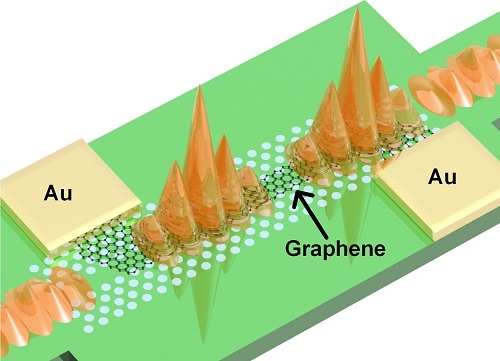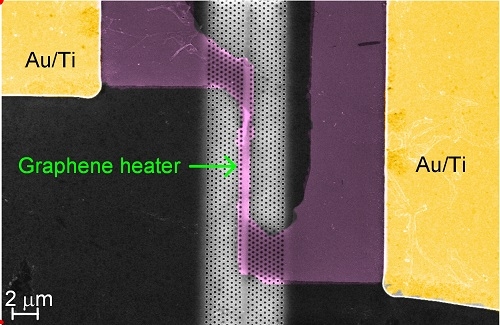On February 9th, Nature Communications published the cooperative research results co-authored by Prof. Dong Jianji of Wuhan National Laboratory for Optoelectronic of HUST, Dr. Ding Yunhong and Prof. Asger Mortensen of Technical University of Denmark (Danmarks Tekniske Universitet). The title of the paper is Slow-light-enhanced energy efficiency for graphene microheaters on silicon photonic crystal waveguides.
In the “Internet plus” era, everyone is enjoying the unprecedented convenient life brought by the flourish of information industry, including high-speed 4G/5G network, various mobile applications, smart homes, unmanned vehicles, etc. All of these supreme technology products, without exception, depend on high performance data processing and core transmission devices behind them. Most of the traditional core devices take electronics as the carrier of information. However, the “electronic bottleneck” makes it more and more difficult for traditional devices to satisfy the increased social requirements of high bandwidth and low energy consumption data transmission and processing. Considering that the optical signal has the properties of super speed, wide belt and low energy, which makes integrated photonic devices the best substitutes of traditional electronic ones. In order to ensure the flexibility and plasticity of integrated photonic devices, integrated photonic waveguides are always overlaid with nanometer heaters made of metal materials. By making use of their refractive index sensitivity to temperature (thermo-optic effect), the electrodes could play a regulatory function on them. However, due to the great light-absorption loss introduced by the metal, there must be a thick isolation layer of oxide between metallic heaters and photonic waveguides in the practical application, inevitably impeding heat transport to the goal waveguides efficiently. As a result of it, it directly causes high energy consumption and low speed within milliseconds in the tuning process. All of these factors have seriously restricted the further development and application of integrated photonic devices.
Researchers from Wuhan National Laboratory for Optoelectronic of HUST and Technical University of Denmark believed that the combination of graphene and slow light effect is an efficient approach to solve this problem after their long-term practice and exploration of tuning of integrated photonic waveguides. As a popular word in recent years, grapheme has become the focus of science and industry owing to many unique physical properties. Made of carbon atoms arranged in a honeycomb-like six-angle lattice, grapheme is a kind of two-dimensional special material with only one atom thickness. Therefore, it has many physical properties that other regular materials do not have. For example, it is almost transparent, with the light absorption of only 2.3%; its thermal conductivity is as high as 5,300 W/m·K. It can be concluded that grapheme is one of the best materials with high thermal conductivity so far. These two unique properties could make grapheme the best alternative to traditional metallic heaters. Compared to traditional heaters, the use of grapheme as a heating material in close contact to the photonic waveguides can significantly avoid the light absorption loss of grapheme and heat loss of the oxide layer due to grapheme’s low light absorption rate. Meanwhile, high thermal conductivity means that it can transmit the heat to the waveguides at an extremely high speed, greatly increased the tuning efficiency.

The clever twist here is that, by adding the grapheme on the photonic crystal waveguide with special band structure upgrading from the traditional waveguide, the performance of grapheme heater can be improved significantly, as shown in figure 2 and figure 3. The reason is that the speed of light in the photonic crystal waveguide is 30 times slower than it in a vacuum, which results in more efficient heating length of optical signal and lower energy consumption of tuning.

Based on the above theoretical support, Prof. Dong Jianji of Wuhan National Laboratory for Optoelectronic, Dr. Ding Yunhong of Technical University of Denmark and Prof. Asger Mortensen carried out a cooperative research and designed the slow-light-enhanced graphene microheater. The test results showed that (see figure 4), the thermal tuning efficiency of the slow-light-enhanced graphene microheater is up to 1.07 nm·mW-1, nearly twice higher than traditional devices. The energy consumption during the 360°phase shift is only 3.99 mW, lower than most traditional metallic heaters. The switch speed of the optical signal is only 550 ns, which, to the best of our knowledge, is the fastest reported tuning speed for nanometer heaters. Moreover, the corresponding figure of merit of the device is 2.543 2.543 nW·s, which is 30 times better than results reported in previous studies. So it is considered as the best nano heater with comprehensive merit. Considering the widely required applications of nano microheaters in the photonic integrated circuits in the future, there exist many challenges in energy consumption and tuning speed. The result of the research presents promising applications in many functional photonic devices, such as integrated phased array radars, optical arbitrary waveform generator and other important communication and state defense devices.

The achievement was published in the international top comprehensive journal Nature Communications on February 9th, 2017. The PhD candidate Yan Siqi is the first author and Prof. Dong Jianji and Ding Yunhong are co-corresponding authors. The project was supported by the Chinese Outstanding Youth Fund of the National Natural Science Foundation (No. 61622502), Danish Independent Research Fund (DFF-1337−00152 & DFF-1335−00771) and Danish National Research Foundation (Project DNRF103).
